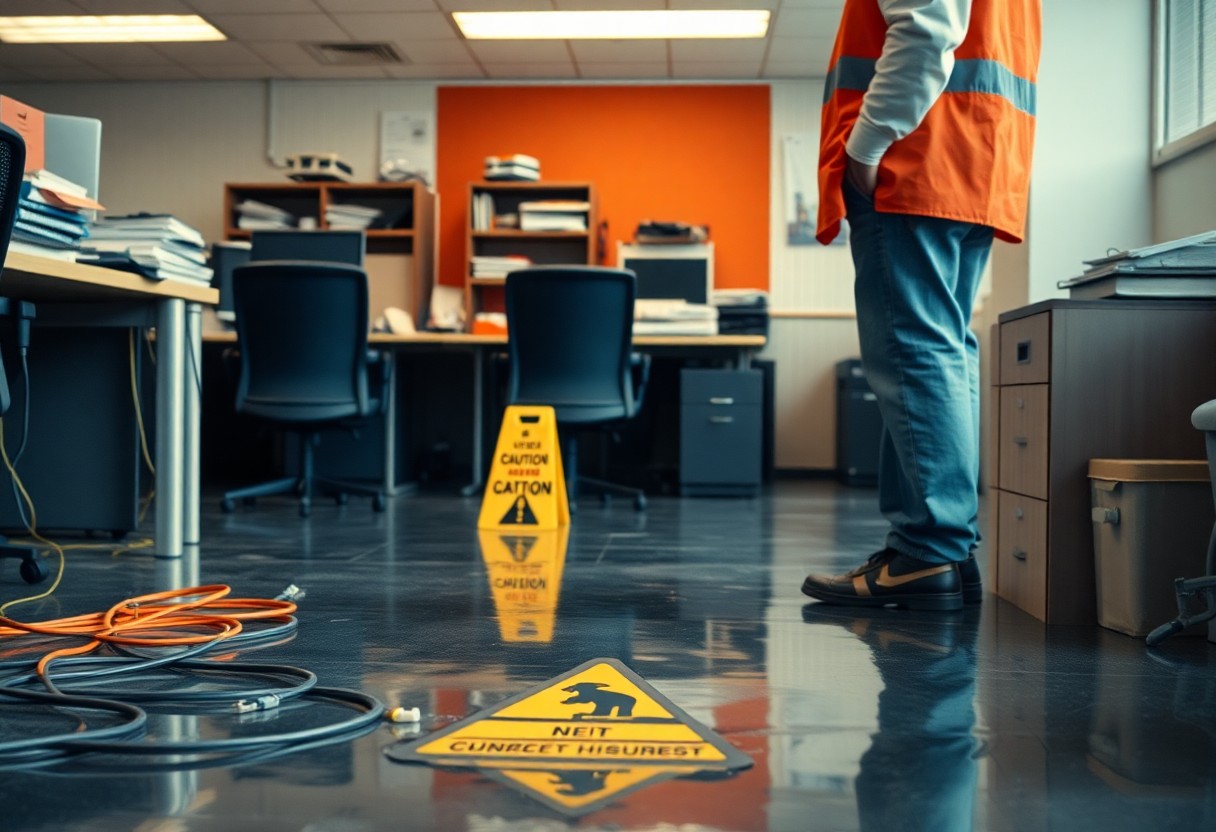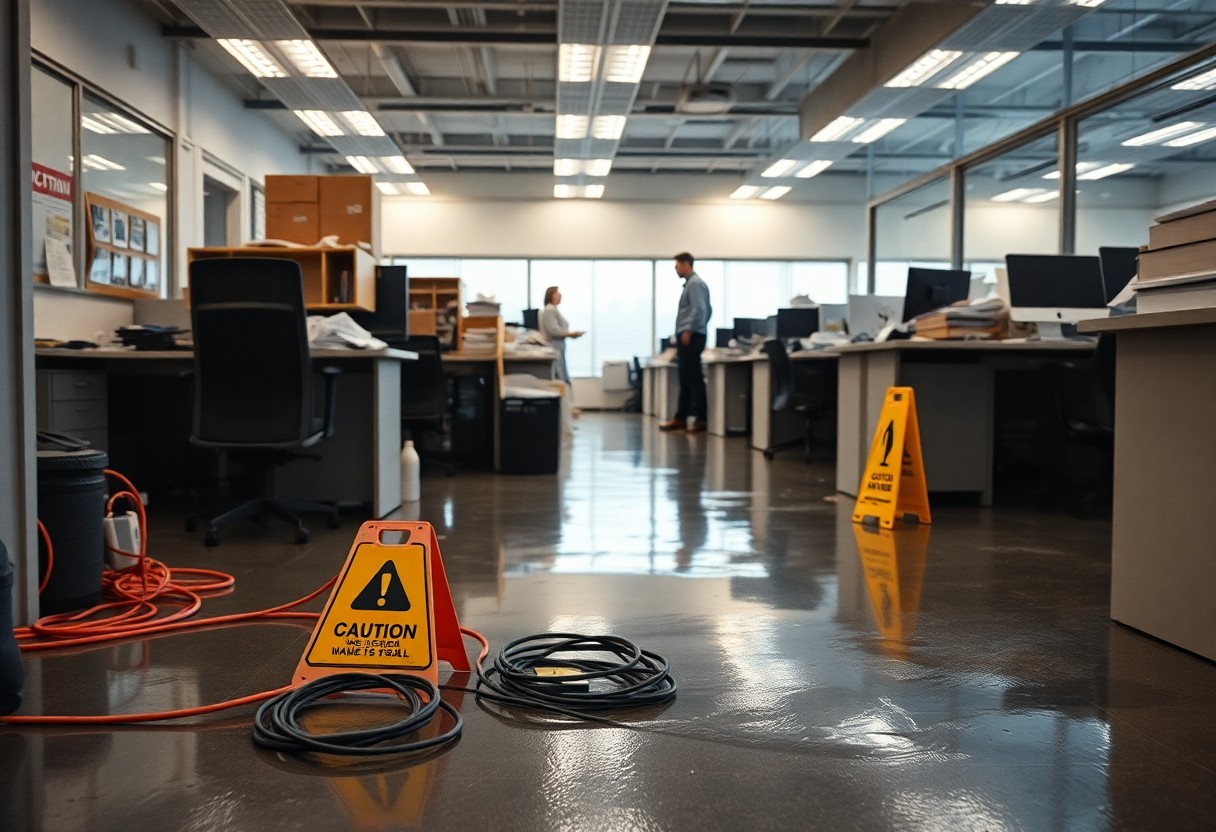Just because you’re in an office doesn’t mean you’re free from hazards. Every day, your workspace presents potential dangers, from slips and trips to ergonomic issues that can affect your health. It’s important to stay vigilant and identify these everyday risks to ensure a safe working environment for yourself and your colleagues. By remaining aware and taking proactive measures, you can significantly reduce the chances of accidents and promote a culture of safety in your office space.

Key Takeaways:
- Daily office hazards, such as cluttered walkways and improper ergonomics, can lead to injuries.
- Regular safety assessments and employee training can enhance awareness and prevention of workplace injuries.
- Encouraging open communication about safety concerns promotes a safer work environment.
Identifying Common Office Hazards
Recognizing common office hazards is necessary for maintaining a safe work environment. Everyday dangers often stem from the very furniture and equipment designed for your comfort and productivity. Issues such as poor lighting, cluttered walkways, and outdated equipment can lead to serious accidents. Conducting regular assessments of your workspace will help you identify these hazards and take action to mitigate them.
Ergonomic Risks
Ergonomic risks arise when your workspace isn’t designed to fit your needs. Poorly positioned monitors, chairs lacking proper lumbar support, and keyboards at an incorrect height can lead to chronic pain and discomfort. It’s necessary to adjust your workstation to promote a healthy posture, thereby reducing the risk of musculoskeletal disorders.
Slip and Trip Hazards
Slip and trip hazards are prevalent in office environments and can lead to significant injuries. Be vigilant about keeping floors clear, addressing spills promptly, and using anti-slip mats in high-traffic areas. These seemingly minor issues can have serious repercussions if not addressed.
Incidents of slips and trips remain among the top causes of workplace injuries, accounting for around 20% of all reported accidents. In offices, common culprits include loose rugs, wet floors from spills, or cluttered walkways. Ensuring proper signage for wet floors, regularly maintaining your space, and conducting training on identifying hazards can greatly reduce such risks. Regularly monitoring areas prone to hazards can help create a safer workplace for everyone.
Proper Equipment Use
Using equipment safely in the office is vital to prevent injuries. Ensure you are trained and familiar with any machinery or technology before use. This includes understanding the specific functions and limitations of equipment like printers, shredders, and computers. Always follow the manufacturer’s guidelines and report any malfunctioning devices to your supervisor immediately to maintain a safe workspace.
Safety Gear Essentials
Your office may require certain personal protective equipment (PPE) depending on the nature of your work. Items such as anti-glare glasses for computer users or non-slip shoes in areas with potential spills are necessary. Wearing the appropriate gear not only protects you but also fosters a culture of safety among coworkers.
Equipment Maintenance Protocols
Regular maintenance of office equipment is key to ensuring safety and functionality. Establish a routine for inspecting machines, cleaning them, and replacing parts as needed. Keeping a maintenance log can help track service dates and remind you of upcoming checks, reducing the risk of equipment failure during use.
Implementing maintenance protocols involves assigning responsibilities to specific team members and scheduling regular reviews. For instance, monthly inspections can cover items like printers, ensuring ink levels, and checking for paper jams, while bi-annual checks might involve a deeper cleaning of computers and other technology. Having a dedicated checklist can further enhance efficiency, ensuring nothing gets overlooked, which minimizes downtime and potential safety risks. A well-maintained office environment is not just about aesthetics; it directly correlates to employee productivity and overall safety.
Emergency Procedures
Understanding and implementing emergency procedures is necessary for ensuring a safe workplace. Whether it’s a fire, natural disaster, or medical emergency, having a clear plan in place can save lives. Familiarize yourself with the specific protocols your office has established, including who to contact, how to respond, and the steps to take during an emergency. Conduct frequent drills to ensure everyone knows their role and can act decisively when necessary.
Evacuation Plans
Your office should have a well-documented evacuation plan that lays out the routes and exits to take in an emergency. Ensure these plans are visibly posted and easily accessible. You should conduct regular drills, so employees are practiced and comfortable with the process, reducing confusion and panic during a real emergency. Designating specific individuals to lead the evacuation can also enhance safety and order.
First Aid Readiness
Evaluate the first aid readiness of your workplace by ensuring accessible first aid kits and trained personnel. Regularly check the supplies in your first aid kits to replace any expired items and confirm the presence of necessary tools like bandages, antiseptics, and emergency contact information. Encourage training for employees in first aid and CPR, as this not only empowers them but can also drastically improve response times in emergencies.
Having at least one certified first aid responder in your office is a significant safety asset. Studies show that quick first aid can reduce recovery time from injuries by up to 50%. You can designate a specific person or multiple team members to take a first aid training course, empowering them with the knowledge to act effectively during incidents. Regular training sessions and refreshers not only keep skills sharp but also foster a culture of safety within your organization.
Personal Responsibility and Safety Culture
Your role in developing a strong safety culture is imperative. Personal responsibility means actively engaging in safe practices and holding yourself and your colleagues accountable for maintaining a safe environment. Implementing Daily Workplace Safety Messages Examples can strengthen shared awareness and highlight the importance of safety in daily operations. When every employee takes ownership of safety, it fosters a collective commitment that significantly reduces risks.
Reporting Hazards
Promptly reporting any hazards you encounter is vital for preventing accidents. If you see a spill, broken equipment, or any other safety risk, notify your supervisor immediately. Establishing a clear process for hazard reporting encourages a transparent environment where safety concerns are addressed swiftly, enhancing overall workplace safety.
Promoting Awareness and Training
Continuous awareness and training are key to maintaining safety standards. Regular safety meetings and training sessions equip you with updated knowledge on potential hazards and best practices. Incorporating practical exercises and real-world scenarios in training reinforces your understanding and preparedness for emergencies.
Besides formal training sessions, fostering a culture of safety awareness encourages open conversations about hazards and safety practices. Utilize visual aids like posters or digital communications to keep safety top-of-mind. Engaging employees through workshops and hands-on training cultivates a proactive mindset towards safety, ultimately leading to fewer accidents and a healthier workplace environment.
Role of Management in Office Safety
Your management team is crucial in fostering a culture of safety throughout your office. They must prioritize safety practices, allocate necessary resources, and lead by example. When leaders visibly engage in implementing safety protocols and addressing hazards, it sets a standard that encourages everyone to follow suit. Consistent communication and support from management ensure safety remains a top priority, which can ultimately enhance employee well-being and productivity.
Safety Policies and Guidelines
Effective safety policies and guidelines provide a framework for navigating everyday hazards. These documents should outline clear procedures for reporting unsafe conditions and detail the responsibilities of each employee in maintaining a safe work environment. Additionally, they should be regularly updated to reflect changes in regulations or identified risks, ensuring everyone is aware of the latest safety practices.
Ongoing Risk Assessment
Ongoing risk assessment is vital for identifying potential hazards in your office. Regularly scheduled evaluations help spot risks before they lead to incidents. By involving employees in these assessments, you can gain valuable insights into overlooked dangers, enhancing overall workplace safety.
Engage your team in safety inspections every quarter to pinpoint issues like poor lighting, cluttered walkways, or malfunctioning equipment. Utilize checklists and engage employees by allowing them to report hazards anonymously. Document findings rigorously to track improvements or recurring issues, and make adjustments to safety protocols accordingly. By making ongoing risk assessments a shared responsibility, you foster a proactive safety culture that minimizes risks and maximizes workplace efficiency.
Summing up
So, prioritizing office safety is necessary to protect yourself and your colleagues from everyday hazards. By staying vigilant and addressing potential risks, you contribute to a safer workplace environment. Take a moment to assess your surroundings, report unsafe conditions, and adopt safe practices. Your proactive approach not only safeguards your well-being but also creates a culture of awareness and responsibility among your peers. Make safety a daily habit to ensure that everyone goes home unharmed.
FAQ
Q: What are some common everyday hazards in the office?
A: Common hazards include cluttered walkways, loose electrical cords, wet floors, improperly stored items, and poor ergonomics. Regularly identifying and addressing these hazards can help maintain a safe work environment.
Q: How can I improve my workspace ergonomics to enhance safety?
A: To improve ergonomics, adjust your chair and desk height so that your feet are flat on the floor and your arms are at a 90-degree angle when typing. Use monitor stands to keep screens at eye level and take regular breaks to reduce strain on your body.
Q: What steps should I take if I identify a safety hazard in the office?
A: First, report the hazard to your supervisor or the office safety officer immediately. If safe to do so, take measures to minimize the risk, such as cleaning spills or moving obstacles. Follow up to ensure appropriate actions have been taken to address the issue.
